#revolutionary iconography
Text
Fragile.

#frev#french revolution#frev art#robespierre#maximilien robespierre#thermidor#art#traditional art#my art#revolutionary iconography
70 notes
·
View notes
Quote
I’m actually seeing people write articles comparing those raised fist images to the iconic flag raising on Iwo Jima or various paintings from the Revolutionary War or Christian iconography. A column ran today on The New York Times op-ed page in which the author explained that Saturday’s events convinced him that Trump was what Hegel described as a “man of destiny” on the model of Napoleon, a figure “whose own particular aims involve those large issues which are the will of the World Spirit.”
JESUS CHRIST.
If you can’t take in this nonsense and say, nope, I’m going to head straight to Milwaukee and make the case against this dangerous degenerate, than you just need to resign or get out of the way and make room for someone who can. No complaining, no whining. Act.
On Not Being Pathetic
534 notes
·
View notes
Text
we need plentiful feminist street art because readily accessible iconography and arresting visuals are essential to the sense of well-being of the revolutionary woman
480 notes
·
View notes
Text
In season 1, Powder/Jinx was viewed by most as a screw-up, and a monster.
In season 2, Jinx will be viewed by most as a monster, and a revolutionary symbol.
In neither season did the majority opinion see her as a person. Those who did care about her as a person — Vander, Vi, Ekko (though he tried hard not to in arcs 2 & 3), and Silco, in that order — were heavily outnumbered by those who only saw her as the consequences of her actions, and not the eccentric, brilliant, but heavily traumatized and mentally ill girl she actually was.
There are some people who are angry that she is being seen as a revolutionary or peaceful symbol in Zaun. "It should be Vi!" they say. "How could they do this to Ekko?!" But here is what those people are missing:
Symbols are not people. They are iconography. A symbol can last long, long after its origin has died. Hence why doves are symbols; they can die fast, but their paintings last forever. This means that it does not matter at all to Zaun what happens to Jinx, in any way, once she is their symbol; even if she dies, that just makes her a martyr. Even better if it's an enforcer that kills her. (I could see Sevika arranging that.)
Jinx is just as alone now as she ever was. Symbols need to stay pure. Meaning that Jinx's off-color jokes and wild actions will need to be short leashed or she could risk losing that status. Even IF she feels this gives her community, she'll lose that real fast.
This is not the face of a girl who feels she is among friends:

And that is simply because she isn't. They don't know her. They don't need to know her. They need her to do her part (be the face on the murals, the martyr when we need it) and that's it. Jinx's action of blowing up the council was loved. But Jinx herself? No.
This is not an enviable position and it isn't going to benefit her, at least not in terms of her mental wellbeing. Jinx needs real unconditional love and support—what she got from Silco in his final moments, not the empty veneration of the masses who view her as an icon rather than a human being.
#arcane#arcane spoilers#powder#jinx#and no it wouldn't fit Vi or Ekko either — bc one never wanted to save Zaun (Vi)#and the other never wanted to be a symbol (Ekko)#Vi only ever wanted to save *her family* and Powder especially#she says in arc 1 she wanted a better life *for Powder*#she had no interest in making the undercity better. she DID have interest in making the undercity RESPECT her#she was closer to Vander's ideals post-prologue bc Vander USED to want to save Zaun#but gave up after his failed revolution and chose to focus on saving / protecting his family#which is what Vi wanted also. but she also had an edge of bitterness toward Zaun that came with being 15 lol#but i think Vander is on the mural for his times pre-bridge when he DID want a revolution + no one knew he worked w/ Greyson#meanwhile EKKO is the ACTUAL revolutionary y'all pretend Vi is. the Boy Savior#but Ekko DOESN'T WANT to be a symbol! he doesn't do it for accolades!#i mean he wears a friggin mask dingus!!! for safety from enforcers yes#but i think also so normal Zaunites can't clock him#Ekko is in it to make Zaun better. he wants to do the grassroots work - NOT the politics that symbols require#(Jinx also doesn't do politics but notice it's not HER idea)#also Ekko doesn't go around launching missiles at thw piltover council. so you know. there is that.
49 notes
·
View notes
Text
The penetration of China by Buddhism not only gave the Chinese a new religion but, of central importance to this narrative, it gave to the world an entirely new style of art which has come to be known as Serindian. This term is coined from the two words Seres (China) and India. Logically it should have been simply a fusion of Indian Buddhist art and the art of contemporary Han China. It almost certainly would have been had it not been for the great Himalayan massif which so effectively isolated China from all direct contact with India. But faced by this impenetrable barrier, the gospel of Buddhism together with its art came to China by a roundabout route, gradually absorbing other influences on its way. Its real point of departure was not India proper but the Buddhist kingdom of Gandhara, situated in the Peshawar valley region of what is now north-western Pakistan. Here another artistic marriage had already taken place. This was between Indian Buddhist art, imported by the ruling Kushans (descendants of the Yueh-chih) in the first century AD, and Greek art, introduced to the region four hundred years earlier by Alexander the Great.
The most revolutionary product of this Graeco-Buddhist, or Gandharan, school was the depiction of Buddha in human form, for it was the first time that artists anywhere had allowed themselves to show him thus. As a being who had ceased to exist, theologically speaking, by achieving Nirvana and thus escaping the endless cycle of rebirth, he had always been portrayed before by means of a mystical symbol such as a single footprint, a wheel, a tree, a stupa or Sanskrit characters. But the Gandharan Buddha is shown by sculptors with straight, sharply chiselled nose and brow, classical lips and wavy hair–all Hellenistic influences. Another obvious Mediterranean introduction is the diaphanous, toga-like robe he wears in place of the expected loin cloth. But his eyes are heavy-lidded and protruding, the lobes of the ears elongated, and the oval-shaped face fleshy–all characteristics of Indian iconography. The stretched ear lobes symbolise Buddha’s casting away of the heavy, jewelled and worldly earrings that he had worn as a wealthy prince before his conversion to a life of self-denial and teaching
—Peter Hopkirk, Foreign Devils on the Silk Road: The Search for the Lost Cities and Treasures of Chinese Central Asia
#peter hopkirk#foreign devils on the silk road#history#china#india#gandhara#Buddhism#art#w#2024 reads#upl#reading through the silk road
28 notes
·
View notes
Text
I also made this post on the BRC subreddit but unsure if it'll stay up there so I figured I'd also share here on the off chance it gets taken. Just had thoughts about the visual symbolism with Faux and Felix that I needed to get out of my system.
Spoilers ahead for Chapter 5 and BRC endgame!
When I was going into the final boss fight, my best friend had wanted to be on voice call because there was a particular shot after the fight that she really wanted me to see: the one where Solace became Felix's "one wing".
Considering Felix going solo catalyzed the contention between him and Faux, the way Felix's "I only need one wing" mentality evolved between his first All City to the end of BRC's narrative is one of the things that really struck me with this shot. Felix's one wing was initially something borne from his decision to break away from the Big 3 in order to go solo — relying on his own merits in order to reach the pinnacle of the streets. It's never explicitly said if he really thought of Faux as a burden ("Felix... you never wanted us to be a crew and why would you? You gained so much from dropping me.") but from Felix's perspective, there were "no hard feelings" which implies that there was no actual resentment on his side. DJ also certainly didn't seem to really care either way. But ultimately the choice to be on his own with his one wing is the thing that led to his death, since Faux took it hard enough that he... y'know...
But with this?
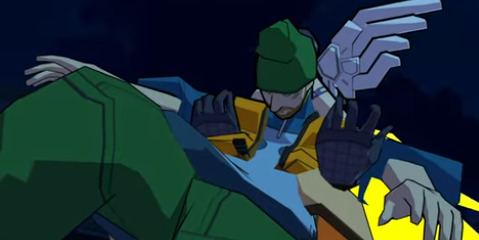
[ID: Felix with one of Solace's wings showing up behind him]
Sure, it's just Solace. But Solace represents more than just himself — Solace represents BRC, all of them. The entire narrative follows Felix as Red, back at the bottom of the rung with Tryce and Bel, as the three of them work to the top. As Red, he still had inclinations towards handling his whole "retrieving his head and finding out his roots" situation on his own. But it was through Tryce and Bel's insistence that they stick together and their constant support and care that overcomes those inclinations. As Red, he intentionally chose and was able to reach the pinnacle with other people, with a crew — something that old Felix thought wasn't possible even when Faux, one of the best of his contemporaries, had offered it.
I think about this shot a lot ever since I saw it in-game. But then I came across another one as I was watching another person's playthrough with the same friend:

[ID: Faux's introduction in Chapter 1 at the New Amsterdam Police Bureau, with the outer ring of the Police Bureau's logo prominent behind his head]
The above shot caught me so off guard because it truly is a "blink and you miss it" kind of moment since Faux zooms in from this particular shot pretty quickly. But the New Amsterdam Police Bureau logo makes a flipping halo behind him. Along with the alias, this could potentially be its own foreshadowing to Faux's real nature: that he's not who he seems to be, that he's your foe, but that he's also deified himself in his own head and eventually deified through Project Algo where he assumes control of the police force.
(And since Solace is sometimes called by other characters as an "angel boy" or Felix's "angel fan", you can potentially get some lovely interpretations stemming from religious iconography, but that's something for another day if not coming from another person entirely.)
Am I reading too much into this? Most definitely. But while the actual plot of BRC isn't revolutionary, a lot of the things that make it enjoyable for me is filling it in with things like this in order to enrich the world and the story more. So I figured I'd also share the joy that came with these random thoughts with others — and if you've made it to the end, thanks for reading!
42 notes
·
View notes
Note
So, about flags, not sure if this is a hot take: but don't you think the red background, yellow stars, maybe hammer&sickle design a lot of socialist states had (or have) is overused and bad? Like flags represent countries, so if all the flag represents is its economic system that seems like a little too empty of a flag imo. It's kinda like if the US had a yellow background and a bank for a flag. The USSR is kinda exempt since they were the first, but then everyone decided to copy their homework.
i mean i do think that a socialist revolution should by any meaningful sense of the world establish an entirely new state, it represents a little bit more than just 'an economic system'--but i do generally agree, i think that adaptations of recognizable communist iconography to the specific revolutionary conditions of the country are better than just straightforwardly copying the hammer and sickle. cf. the wpk, gdr, and mozambique:
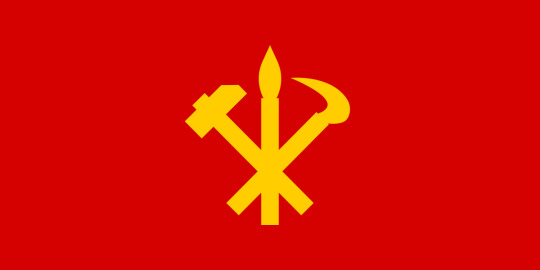


70 notes
·
View notes
Text
Cowboys, capitalist entrepreneurs, American heroes—these are lonely, autonomous heroes by choice, and they are, undeniably, mythologized in American culture; but how "real" are they? And if they indeed represent the "times," doesn’t this raise some rather crucial questions about what exactly is being mythologized as heroic in the ’80s? I am afraid it would be rather difficult to locate cyberpunk’s "good politics," despite Rosenthal’s contentions that cyberpunk writers are on the cutting edge of interesting politics, that they "can’t wait until all the returns are in, until political and economic theorists agree upon new models for the forms underlying social life" (80). Nor, in fact, is it really possible to locate that supposedly "revolutionary" agenda cyberpunk is touted so regularly as having. This is not to say that Gibson and other cyberpunk writers are not excellent craftsmen, interesting stylistically, and capable of constructing complex and gripping plots. But the conflation of aesthetic appreciation and good politics surfaces, in certain critics, as a form of leftist wish-fulfillment; that, in other words, if one likes the fiction, it must necessarily involve the articulation of a perceptible, revolutionary project. To make such an argument, however, is to remain effectively blind to what cyberpunk does represent, particularly when one contrasts it with other forms of political SF. The political (or even revolutionary) potential for SF, realized so strongly in ’70s feminist SF, is relegated in Gibson’s cyberpunk to a form of scary feminized software; his fiction creates an alternative, attractive, but hallucinatory world which allows not only a reassertion of male mastery but a virtual celebration of a kind of primal masculinity. Political potential is indeed lost in the iconography of all that Reagan himself represented.
#not talking about the larger essay#but I read this line and was tickled pink#it happened in the early 90s too!#helio.txt
11 notes
·
View notes
Photo
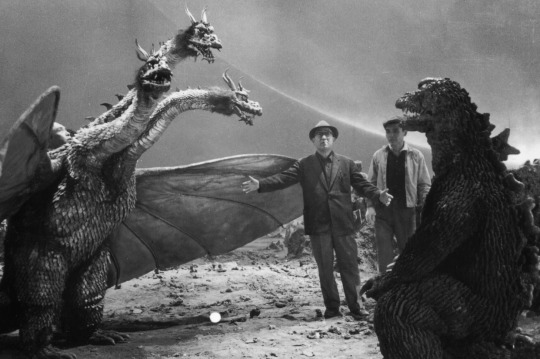

Tsuburaya Eiji, the Father of Tokusatsu
Eiji Tsuburaya made it possible for Godzilla to stomp across the screen and later on, Ultraman. A director, cinematographer, and producer, Tsuburaya is best known for creating the special effects behind Japanese classics like Godzilla and other giant monsters called kaiju.
And his legacy extends beyond those monsters — he built a foundation for film culture in Japan and special effects worldwide.
Before World War II

Tsuburaya grew up in Sukagawa, Iwase, a son of a prominent family of grocery distributors. A prodigy from a young age, as a kid he was interviewed about his model airplanes and credited in local newspapers as a "child craftsman." Shortly thereafter, he was captivated by a new technology called motion pictures — and he combined his two passions by taking pictures of planes.
But it was 1933's King Kong that led to his greatest professional epiphany. King Kong's giant title character and phenomenal special effects opened up a new world of possibilities for Tsuburaya. By studying a copy of the film, Tsuburaya managed to reverse engineer how the effects were made. Then he was ready to begin creating his own legacy.
Being a film revolutionary wasn't easy with his early battles over budget and setup, but when a new company called Toho Motion Picture Company was founded in 1936, Tsuburaya jumped on board to lead the special effects department.
After World War II
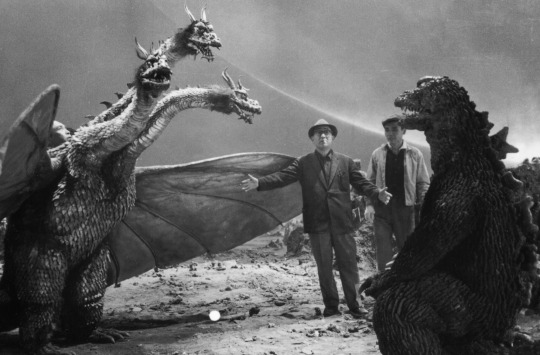
After being drafted to work on propaganda films in World War II and experiencing the napalm bombing of Tokyo, he returned to work at Toho after the end of US occupation in 1952, keeping a low profile because the US believed he'd committed espionage.
It was in that climate that producer Tomoyuki Tanaka was artistically inspired by the fallout of a US hydrogen bomb test in the Marshall Islands. The real story of a radiation-poisoned fishing crew inspired him to pitch a monster movie to Tsuburaya and Toho. After some creative wrangling, Godzilla was born.
For Godzilla, Tsuburaya made the bold choice to use miniatures and visual effects instead of stop-motion animation, which was a more obvious alternative. The idea to put an actor in a monster costume was going to be executed as never before, and with it a legendary monster was born.
Though Godzilla was the product of a large team, it came alive because of Tsuburaya's use of models, special photography, and inimitable costumes.

Godzilla was a tough shoot. Actors were stuffed into a costume that was, at its lightest, 220 pounds. They breathed in kerosene from the fumes of a tiny "Tokyo" model burning beneath them, and actor Haruo Nakajima says he lost 20 pounds in the production because the costume was so physically strenuous.
The film was a financial risk, as well — it became the most expensive Japanese movie made up to that time. But Godzilla was a hit, and it kicked off "monster mania." Film by film, these movies created a kaiju iconography that shaped an entire film industry's sensibility — and built a legacy for Tsuburaya.
Tsuburaya's professional and creative successes continued through the 1960s, as he innovated with more intricate models and formed his own company, Tsuburaya Visual Effects Productions, in 1963 where he created what kaiju superfans consider his landmark work, like Ultra Q and Ultraman in 1966.
Today

Though Tsuburaya died in 1970, his creations remain embedded in the culture today. Even to those who aren't fans of Tsuburaya's distinctive style, his aesthetic, effects, and ethos permeate movies today.
There are obvious influences, like the many Godzilla remakes and the kaiju fan letter that is 2013's Pacific Rim. Without Godzilla, there is no Ultraman. And without Ultraman, there is no Super Sentai (Power Rangers) and so on.
Tsuburaya's influence can also be seen in every disaster movie's audacious carnage and ever-more-adventurous willingness to push boundaries using special effects.
That's probably why we still thrill to learn about the man who made all those monster suits really roar. Because even now, more than 50 years later, it's as exciting, outrageous, and thrilling as when Godzilla first hit the screen.
Thank You Tsuburaya Eiji for making our childhood a memorable one and our adulthood an awesome one!
Pics by Ultraman NFT & Vox
Full Story : Eiji Tsuburaya made Godzilla and it changed film forever
Follow Ultraman NFT & August Ragone if you’re a Tokusatsu fan!
#tsuburaya eiji#eiji tsuburaya#tsuburaya productions#godzilla#king kong#ultraman#ultra q#kaiju#japan#tokusatsu#japanese film#japanese movie#japanese drama#pacific rim#super sentai#power rangers#ultra series
106 notes
·
View notes
Text
Yet the legacy of Las Soldaderas has been almost entirely redefined and retold through a primarily male perspective. It was even happening during the Revolution: Men would write songs about Las Soldaderas, emphasizing their femininity and overt sexuality, in order to diminish their military contributions and accomplishments, according to Fernández’s research. Their image was structured around these male-written corridos. Iconography surrounding Las Soldaderas often featured women dressed in low-cut, skin-tight outfits with ammunition-filled bandolier slung over their chests a la Cruz and Hayak’s Hollywood depictions. These depictions of Las Soldaderas would come to be known as Las Adelitas, named after the famed ballad La Adelita, which described an unknown soldadera who was as pretty as she was brave. Soon, the scandalous depictions of Las Adelitas would become synonymous with the worldwide image of Las Soldaderas.
But Las Soldaderas weren’t fighting for their country in brassieres — they were women often dressed like their male counterparts, in battle-ready trousers and long-sleeved shirts, with bullets strapped across their chest and guns holstered around their waists, although some did wear floor-length skirts. Under the leadership of Petra Herrera, perhaps the most well-known soldadera, a brigade of nearly 400 women aided revolutionary leader Pancho Villa, who wasn’t particularly fond of female soldiers, in his effort to take the city of Torreón from the federales. Others acted as spies across the country, nursed the wounded on both sides of the war, and even used their gender to escape from prison.
“It was hard for people to reconcile: ‘How do we remember these courageous women who were fighting in this war, but we also still continue to treat them badly?’ And one way to negate their contributions is to say, ‘Oh, these sex objects were there as well. These people are very nice to look at, and if you put a gun on them it makes them sexy and dangerous at the same time,’” Fernández says. “[This] really negates the ideas of the toughness, the mestizo toughness, the physical toughness that the women brought with them and their contributions.”
20 notes
·
View notes
Text
After The Revolution Will Never Come
An examination on the realpolitik of revolutionary movements and the perpetuation of the iconography of violence. Originally written for my university final paper. 2,500 words.
-
There will come soft rains and the smell of the ground,
And swallows circling with their shimmering sound;
And frogs in the pools singing at night,
And wild plum trees in tremulous white,
Robins will wear their feathery fire
Whistling their whims on a low fence-wire;
And not one will know of the war, not one
Will care at last when it is done.
Not one would mind, neither bird nor tree
If mankind perished utterly;
And Spring herself, when she woke at dawn,
Would scarcely know that we were gone.
-Sara Teasdale, “There Will Come Soft Rains”.
There is an inherent seductiveness to being justified in your actions. To know without any doubt that you were right; that whatever path you chose was the correct path to take, now and into the future. It makes a world of complicated loose-ends and shades of gray into a perfect aesthetic of simplistic moral values. If you were correct, then it necessitates that something else was wrong; if your side is the right side, then whatever actions you took must also have been right. This is not to assign blame; life is a confusing tangle of messy and ugly truths intertwined with deceptions, many of which happen at the same time, or are even the same thing. To crave the shelter of simplicity, to want to feel the certainty that your idea of your own righteousness cannot be challenged, is perhaps one of the most honest parts of human nature.
Yet while this is an understandable instinct, it is not a good one. Jim Butcher elaborated on a fairly well-known idea of actions only justifiable by ourselves in his quote, “No one is an unjust villain in his own mind. Even - perhaps even especially - those who are the worst of us. Some of the cruelest tyrants in history were motivated by noble ideals, or made choices that they would call 'hard but necessary steps' for the good of their nation. We're all the hero of our own story.”
My fear, however, does not come from the justifications that others do not give our actions. Instead I am more afraid of the normalization of violence that we can accept so long as those around us accept that violence. To be beyond reproach requires a community which believes that to be true of your character; inversely, to be irredeemable and monstrous is not something we choose to see for ourselves, but rather that we judge in how we see others. For Americans, I cannot claim to know the source, but I am certain of its consequences, when I look back even throughout my own short lifetime at the popularization of antiblackness, antisemitism, homophobia, and Islamophobia. Each of these philosophies are predicated on the understanding that an outside group is to blame for the violence being done against them, that there is a shared, unilateral complicity in corrupting evil which must somehow be vanquished.
I think often about the potency of symbols and iconography within the human psyche. Simple images which, through some miracle, have become more than what they could ever otherwise be. Icons are sanctuaries, places of holiness, of veneration. They cease to be mere images and become a representation of philosophies, ideals, and concepts, empowering whatever they represent like a focusing prism might strengthen the light and heat of a ray of sun to set a fire from a single perfect point. Meaning is found in the most illogical of things, but that does not reduce the fact that we find meaning in them nonetheless. So I find it concerning to witness within the modern American politics of the radical leftist revolutionaries what seems to be an unconscious commitment to perpetuation of the iconography of violence.
Consider the guillotine. There have been countless stories of its legend, its grim history attached to the shining blade. Its inventor was the Doctor Guillotin, who sought to create a more humane method of murder ordered by a ruling class of citizens–at the time, there were the options of a headsman or a gallows, both of which caused, ostensibly, too much cruelty in the ending of human lives by human hands. I do not believe that Guillotin would have envisioned the legacy of bloodshed he would allow, but I do not believe that anyone ever expected the bloodlust of the French Revolution to reach such awful heights.
They were awful, without a doubt. Over the course of less than a year more than fifteen thousand people were executed via the guillotine, with another twenty-five thousand being executed through other means. Looking not back to the words of the past, but instead to the philosophies of the present, I believe that the guillotine captures something in our imaginations like no other method of execution ever has. It is a clean, simple, perfected machine, tall and central in wherever it sits, confrontational in its exact function. The great equalizer of all men, Madame Guillotine, for we are all comrades in that we are mortal. And, of course, it is a more humane way to separate men’s ghosts from their bodies.
It is this concept more than any that I think is why the modern revolution’s iconography exists so strongly within the grip of the falling blade. We seek to understand ourselves not as murderers or tyrants, but as merciful victors, somber in our need to enforce justice and rules, refusing to relish the idea of suffering even if there is simply no other course but to kill. To torture, maim, and cause as much agony as possible for our personal delights would be truly ghoulish, unacceptable, and prove that we of course are no better than what we defeated. It is a very Romantic means of death; there is spectacle, but there is brevity. There is poetry to the righteousness of an impartial Sword of Damocles, yet we do not stoop to sully our community’s hearts with needless pain.
All of this is a lie. There is no community worth anything which seeks to root its foundations in the efficiency of ending human life. To kill another person as painlessly as possible due to perceived moral necessity is not a mercy, because it by nature must justify the action of murder. Morality ceases to be a function when the legalization of the taking of another’s life is the source of it.
But still, I cannot pretend I do not understand, or even that I do not want to agree, with many of my fellow anarchists. I see the symptoms of a system of government and commerce which has, with no metaphor or allusion, encouraged the permittance of treating human life as a resource to be extracted for profit. I see private citizens funding with personal billions upon billions of dollars the violent usurpation of a foreign nation to prevent their trillion-dollar businesses from being slightly less of a trillion-dollar business. I see leaders of our country witness the countless murders of black men, women, and children, and call for the communities of the dead to control their anger, instead of controlling the killers that remain unpunished or even become celebrated for the ultimate miscarriage of justice, that which ends in the destruction of human beings. I see my planet not even being granted a slow and limping fading-away as it is instead accelerated to apocalyptic levels of death due to the refusal of sacrificing profit for survival. How could I not understand the need for a means to prove to the kings of our kind that they, too, shall die–and by the hands of those they would continue killing, if need be?
Unrest has moved through our world and nation not as a wildfire has, clean and purifying, but as a plague which infects and sickens the hearts, minds, and souls of us and what we make. Our bitter fury at our own powerlessness to prevent harm being done festers and rots like mold in the pit of a peach, capable of killing everything sweet in the world as it lay just beneath the skin. There is a logic to why the guillotine has become such a potent symbol of change, but I do not want to admit that there is a justification for perpetuating that symbol. To venerate and lionize a means of murder and execution ordered by those in power is, I worry, not just to continue a cycle of violence and the reinvention of structures of suffering we live under now. I worry that, at its very core, it encourages an inability to think of any hope for change that does not glorify death and destruction. Perhaps every act of creation necessitates destruction; perhaps a violent upheaval in the loosing of shackles is inevitable for the future of humanity. Certainly it is difficult to envision a reality of realpolitik that does not begin and end with human death at human hands.
But just because it is difficult, or perhaps even impossible, does not mean that we should not shy away from the iconography of violence-as-politics, of murder-bringing-change. I think there is very little in our government and systemic structures that is worth salvaging, truly, but I think of something other than headless corpses piled in the city square when I try and imagine a better world.
Fire has always been an icon in human history; it predates history, and even predates humans. It is destructive, but its destruction is a purification and cleansing. Nothing remains but ash and charcoal, but because nothing remains, it means that you are free to take an entirely new path, with nothing in the past to shackle you. It appears in Creation myths as both creator and destroyer; the conflagrating Shiva, Lord of the Dance; the father of humanity, Prometheus, stealing flames to gift to the first cold and lonely humans instead of being hoarded by selfish Zeus; Coyote climbs the mountains of the sky to take for us fire from the giants, and now the tip of his tail is burnt black from it forever. It appears in the supernatural as divinatory and healing; the Oracle of Delphi inhaling the burning fumes of the gods; the priests of God lighting candles to exorcise demons; the tarot traditionally depicts The Tower, or The House of God, as lightning-struck and aflame, an omen of cataclysmic destruction and overwhelming catastrophic change. Wherever we look, we see fire and fear it as much as we love it, for it is the flames that both grant us life and warmth and kills all it touches with the same breath.
If we must move away from the perpetuation of violence in revolutionary iconography, I must respect the power of iconography at all. Power abhors a vacuum, and propaganda as a rallying cry is an eminent source of empowerment and strength for our convictions. I think of the wildfires of California, and the chaparral which must be burnt to cinders requires to grow and stay healthy as an ecological biome. Entire ecosystems have evolved with the understanding of their end by flame inevitable, and have tied their births to the ashes that are left behind. It is not in the homeland of my tribe that I see a possible replacement for the guillotine–there is no real romance in a pinecone–but I find it elsewhere.
There is a part of the Cape of Africa called the fynbos, or fine bush. It is a region of land where more than four in five plants are endemic to nowhere else except that miniscule hundred kilometer band. Fires rampage through it every decade or so, eradicating the lush beauty of the hills bright with flowers, each trying to attract the pollination of the sunbirds which live in the region and feed off of their nectar.
It is in the ashes and smoke of a wildfire which has left nothing of the old world that I find what symbol I see myself in. Four days after the conflagration, a single flower will have bloomed; the Cyrtanthus ventricosus, commonly named as the fire lily. These plants bloom only after the soil their bulbs live in are exposed to extreme temperatures; they are exclusively pollinated by a single species of butterfly; within two weeks, the flowers will have died as the rest of the fynbos explodes back into vegetation, and it goes dormant once more as a bulb, waiting for the next fire to come, as I suppose it must know it always will.
I want to be clear: I do not see this as an appropriate symbol because of the idea that it represents the hope of a future where justice has won. I think that the lie of victory over oppression is perhaps the greatest danger we face as Americans; we are too easily comforted by the idea that the fight for civil rights and humanity can exist in the past, definitively beaten, or only ever in the smallest dregs, never truly a threat anymore. The idea of history being something we create, as opposed to something which does not apply to us, is not seductive as righteousness is, but rather a terrified grip onto complacency: If we live in times where injustice must be fought, then that means if we are not fighting injustice, we are why it must be fought. The fire lily, on the surface, lives only after the revolution of fire. It is perhaps to others a sign of beauty, perhaps of hope, that life shall exist even after the most calamitous of change.
To me it is the knowledge that the fire lily did not come to life after the fire–justice does not live only once injustice is defeated. The fire lily is a lily. It is a plant which grows from the same bulb, flowering again and again, withering away each time and waiting for its moment to bloom. It is never dead, it may only be killed; otherwise, it is still there, just below the surface of the soil, unseen and ignored by many, but exists within the foundations of the world nonetheless.
The point in time where any of us will ever be able to say, “This is after the revolution”, will never come. The fight against human cruelty, against murder and violence in all its sizes and shapes and justifiications, against conflict and struggle and suffering–it is never something able to be won. We exist in a constant state of learning more about our fellow man, and our ideas of justice grow with each new thing we learn. To be alive is to change into something other than what you were mere moments ago; to be dead is definitionally to stagnate, unable to change yourself, merely to be changed by those around you. The fire lily did not grow after the revolution, it merely was most visible then. Fire happens when we grow rampant and green and far too comfortable with the idea of forgetting that, just like justice exists within the foundations of our societies, so too does injustice, waiting to strike. The only difference between the fire and the flower in this system of symbology, then, is merely what symbols we see in them, and what we are willing to do about it.
86 notes
·
View notes
Text
Three Clerks
Last week I tweaked my back. It hurt. A lot. As I recovered, I found that sketching with pen and pencil was less strenuous than writing on keyboard. So that's what I did.
Sketched characters from an adventure I am currently writing for Colin Le Sueur's We Deal In Lead. It began as a homage to Wisit Sasanatieng's tomyamgong western Fa Thalai Chon / Tears Of The Black Tiger.
+++

SHIN SUL SHAP, SHRINE CLERK
4 Grit 10 STR 10 DEX 10 HRT
Switch (d4)
Face hidden by a broad-brimmed bonnet and veil. Patrols the lines of pilgrims; like a schoolmarm she thwacks anybody chit-chatting. Piety should be silent!
A waif snatches a lead token from her pouch, and bolts. A chase ensues. He begs your help. If Sul Shap finds him, she will sell him to captive takers.
+
Sul Shap is a clerk at the Shrine To The Headless Sun: a bare plaza; a marble pavilion; a golden man, with an ever-burning flame where his head should be.
The Headless Sun is patron saint of the Admiralty, whose laws now govern both Ocean and Sea. He was its founder. The kings of old captured and beheaded him. He overthrew them anyway.
+++
References for Sul Shap were basically Buddhist nun robes (mainly for the volume of fabric), plus an European bonnet.
Initially I'd imagined a conventional broad-brim hat---ie: her veil would be a cylinder around her whole head. But as I sketched I thought the bonnet made a more interesting shape? Also its rear was an opportunity to create a crest / halo of sun-rays. Religious iconography!
Alms bowl, because giving is a virtue. But the Headless Sun values ego-death, not asceticism---so colourful beads and gold amulets and pouches full of lead tokens (money).
+++

RIS SHAY NAM, RECORDS CLERK
2 Grit 10 STR 10 DEX 10 HRT
Swung typewriter (d4)
In a wheelbarrow, pulled by a servitor, typewriter balanced on her belly, pockets filled with banana fritters. Greasy fingerprints on any document she works on.
Shay Nam thinks herself a moral soul. Will side with abolitionists and revolutionaries, with justice—until her own skin is at risk.
+
Shay Nam works at the Hibiscus Court. Princess Khur San, distancing herself from the old order, surrendered this palace to bureaucrats.
Clerks have filled its once-airy halls with shelves. By sympathetic sorcery, all contracts in the province manifest copies here. Rumour has it that this magic works both ways.
+++
This was my first sketch. In pain and bored I just started drawing.
No references, and it shows? Skirt and stockings and boots because these were the easiest for me to do. In my mind Shay Nam was an archetypal overweight NEET. Here she looks to be a sassy layabout. I like her better, now!
Also: a servitor is an empty body. Created when you ritually touch a shrine-stone to the Headless Sun---your soul is obliterated. What is left behind is mindless, hence the harness and reins.
+++
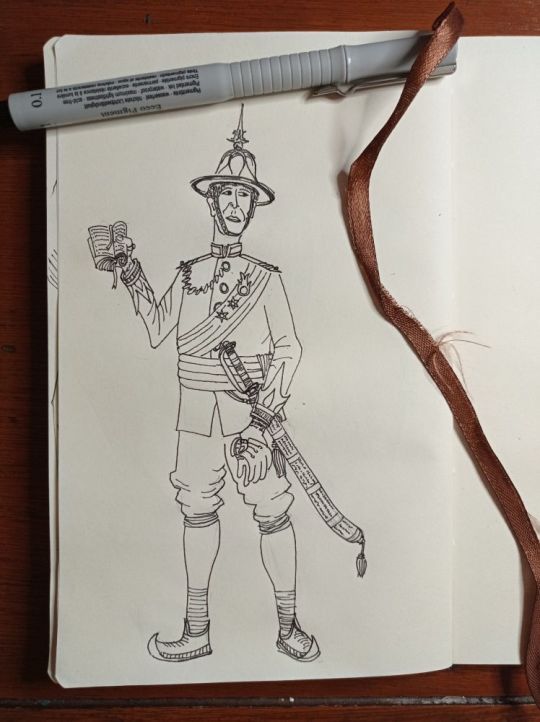
KHAN YUL MIN, COURT CLERK
4 Grit 1 DEF 10 STR 10 DEX 10 HRT
Sabre (d8)
A university grad and former marine. But his townhouse sits below Rose Hill, on Merchant’s Row, beneath the old families' notice.
Yul Min means to change this. He has his eye on the Widow Gon. He will hire ruffians to waylay her palanquin—then swoop in, to rescue her. Elaborate theatre.
+++
Yul Min, like all these characters, live on the Sea of Sorrows, whose waters are literally the souls of the dead.
Roses always bleach within sight of it; to retain their colour they must be shipped in glass, then kept in arboreta—never once sharing air with the Sea.
Those who can afford red-rose gardens tend them on the south end of the city, where streets begin to climb Mount Go, in compounds walled like fortresses.
+++
Drew Yul Min last night. Had tabs open for "Thai traditional clothing" & "military uniforms 18th century" & "krabi" & "Vajiralongkorn".
Given my inspiration, I think the referencing of Mainland Southeast Asian material culture is appropriate. Maybe a little to obvious, though? Ie: the visual forms haven't been composted well, into new and more imaginative shapes ...
Still: very pleased with the proportions and details.
I liked how the hamsa-esque icon of the Headless Sun developed over the course of these sketches. I would not have discovered it, otherwise; it's one of those details, too small for words.
Drawing is an intrinsic part of the writing process, I guess!
+++
#writing#art#illustration#sea of sorrows#ttrpgs#characters#clerks#process notes#we deal in lead#fantasies#adventures#settings
13 notes
·
View notes
Text
#1 - Galaxian (1979) (Yes, Actually)

What the? You said you'd be playing all the Pacs! But that's clearly Galaxian! What gives?! Well, if you'll just sit down, you'll understand a bit...
So... Technicality is a funny thing. One moment you're sitting down to play every single Pac-Man game you can think of in chronological order, and the next thing you know, you're playing a game before Pac-Man chronologically released. Such is the power of highly-specific iconography that would later come to be heavily associated with the series actually appearing in a game before it even existed!
So. Galaxian. You've probably heard of it if you've heard of video games before--or at the very least, you've heard of its older brother, Galaga. While the latter doesn't meet the requirements to be a Pac (and quite frankly, this game almost didn't), there's juuust enough here that makes us raise an eyebrow and say, "this'll do."
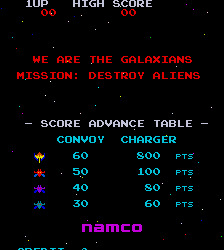
What's this? Why, at the top of the "Score Advance Table" is none other than... The word "Convoy"! And below that and to the left is none other than the Galaxian Flagship. On the off-chance you've never gotten far enough in Pac-Man before, or just never used his Neutral B in Smash, that there alien flagship was effectively Namco's de-facto mascot before Pac-Man really shook things up for them. As a result, it got a cameo in the first Pac-Man game and has been closely orbiting Pac-Man ever since!
Also, wait, the Galaxians are the heroes and we're just fighting aliens? That's definitely strange, seeing as in Galaga the enemies are manned by the "Boss Galaga", which seems to imply the alternative.

Though, not as strange as the fact your ship is also called a... Galaxip. Just rolls off the tongue there.
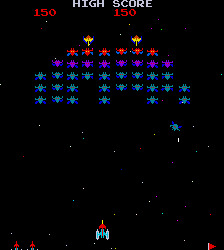
Okay, one thing that's not apparent in these still images is that this game is shrill. Like, very high-pitched and very squeaky. Especially compared to many other early Arcade games, it sticks out like a sore thumb in just how dang loud this game is. Anyways, the standard game loop of Galaxian aren't really anything to write home about--and they weren't even when the game first released. Space Invaders had already existed for some time, after all.
No, Galaxian stood out for a few other reasons. For one, as that cyan alien is kindly demonstrating, the aliens don't just sit there and take your fire, only occasionally firing back. No, when an alien wants to fire back, it descends from formation to both shoot at you and also try and take a swing at you--contact damage will kill you! Secondly, and why those Flagships are so important and why this game was as revolutionary as it was...

Yep, the enemies actively employ the buddy system. Flagships will bring up to 2 Red Aliens with them at a time, descending upon you with not only increased firepower, but the red aliens will actually serve as a meat(? spacecraft?) shield for the Flagship, tanking shots themselves to prevent you from getting a solid shot in.

They do a good job, evidently, because wow we stink at Galaxian. We'd like to think we're okay enough at video games--we've got a few challenge runs of games much more complex than this under our belt--but it just goes to show that sometimes the simplest things to grasp can totally kick you in the shins.

In addition, however, there's one last detail; should there only be a few aliens left standing, they'll enter a sort of panic mode and, instead of returning to their spot in formation, they will gladly charge you endlessly. Forever, if necessary! Until either you shoot them down or they take you out, they will endlessly circle from the top to the bottom, wrapping back around and occasionally firing at you.
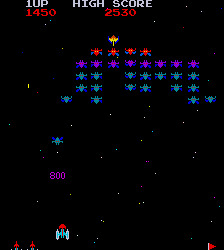
So, let's say you brave the trials that the Flagship ship poises, and properly gun it down in spite of its bodyguards. The game's actually equipped to handle various possibilities and reward you accordingly for how "dangerous" the game deemed it. The factors--as far as we could tell--are if the Flagship died last, and how many Red Aliens guarding it you took out. Pictured is the result of gunning down the maximum two red aliens guarding a Flagship, before gunning the Flagship itself down. This resulted in 800 points, the maximum amount you can get out of a Flagship! It's worth mentioning you only have one bullet per round, so your aim needs to be pretty good to get this. One miss and that thing will gladly rocket to the other end of the screen, leaving you a sitting duck while the aliens get to circle back unscathed.

You may be wondering if anything unique happens if you clear the board of all aliens. Does the game end? Are the Galaxians safe from the intergalactic conflict they've found themselves in? Do the aliens do a little dance?
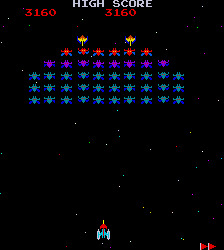
Nope, the round simply resets and a new set of aliens shows up. You actually get a little indicator of how many rounds you've cleared in the bottom right, however--looking it up, the game will actually abbreviate the flags if you clear 10 rounds of this. Can you imagine 10 rounds of pure, unaltered Galaxian? Too much for us, at least.

Still, this was a fun time, and we're glad we got to sit down and warm up to this project with this game. Get our proverbial feet wet, and all that. But let's be real here--you didn't come here for the Flagship. You're here for a different guy entirely.
Never you mind, we getcha, and we hear ya loud and clear. And no fake-outs next time; we're playin' the original Pac-Man. See ya whenever we get around to that one!
#all the pacs#pac man#pacman#1979#galaxian#one of our favorite bits is when a series of games technically starts with a game seemingly unrelated#like how in raocow's ill-fated all the sonics it turned out Flicky was the first game to meet his definitions#or how every mario game technically ties directly back to Donkey Kong. a game not named after mario at all#we hope we did this bit justice
7 notes
·
View notes
Text
Fuck it. Let's steal more shit from Cuno's dad.

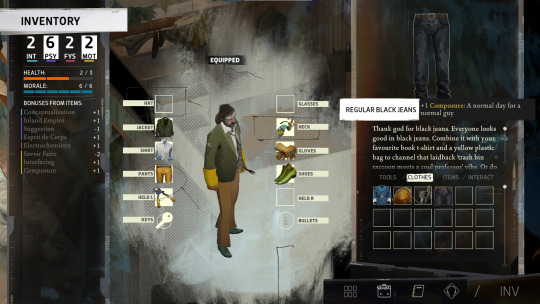
REGULAR BLACK JEANS
+1 Composure: A normal day for a normal guy
Thank god for black jeans. Everyone looks good in black jeans. Combine it with your favourite book t-shirt and a yellow plastic bag to channel that laidback 'trashbin raccoon meets a cool professor' vibe. Or do whatever you want -- it's just a pair of black jeans after all.
Finally, some good clothes. I equip these.
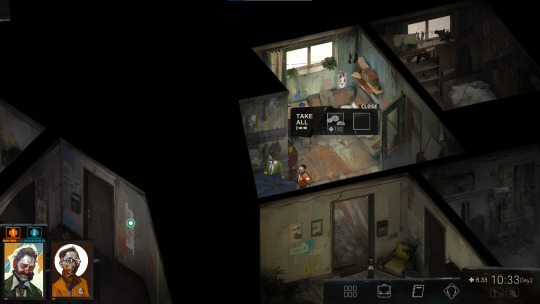
I also take 1.10 real.

Here there's a door that leads to the Smoker's balcony.
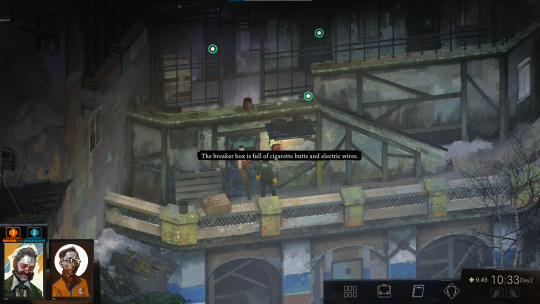
The breaker box is full of cigarette butts and electric wires.
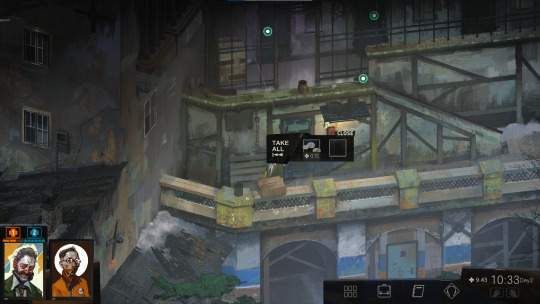
0.15 real...
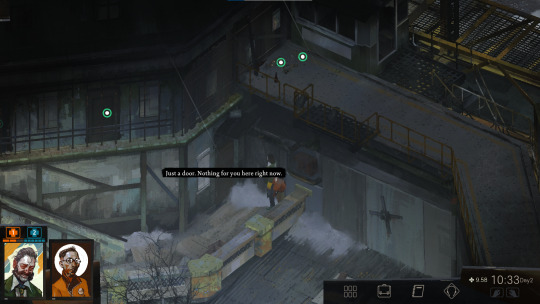
Just a door. Nothing for you here right now.
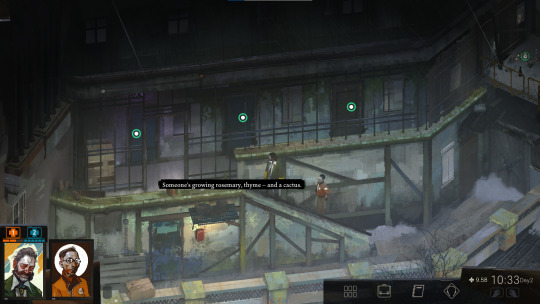
Someone's growing rosemary, thyme -- and a cactus.
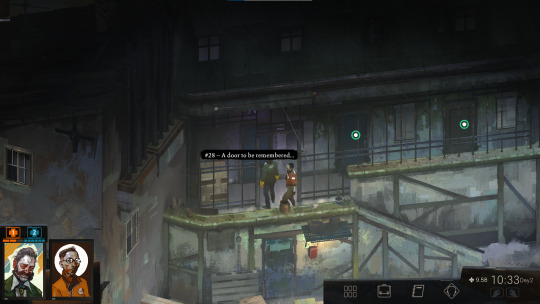
#28 -- A door to be remembered.
This is the door to apartment #29.
This is the door to apartment #30.
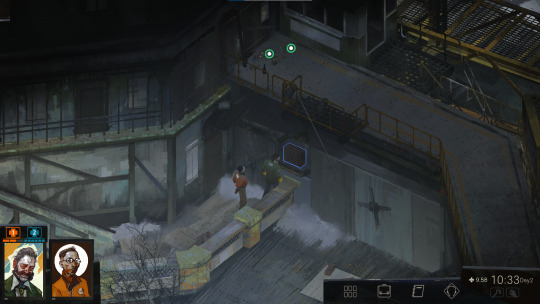
Equipping the prybar allows us to open this box. There's 0.75 real inside.
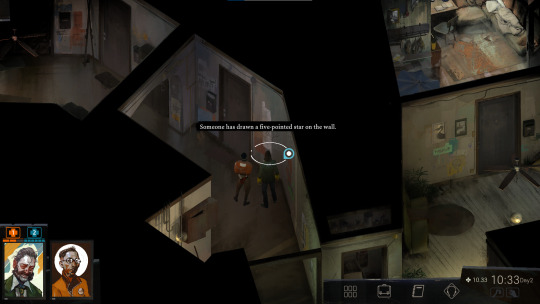
Someone has drawn a five-pointed star on the wall.
ENCYCLOPEDIA - That isn't *just* a five-pointed star -- it's an inverted white pentagram cradled in a wreath of antlers. The iconography of communism, in other words.
Inspect the symbol closer.
[Disregard thought.]
ENCYCLOPEDIA - The star-and-antlers was developed in the sixth decade of the last century and quickly adopted by Mazov and the communards during the Revolution...
Even today, half a century after, the star-and-antlers retains the ability to evoke hope, disappointment, and fear in equal measure.
Why is the star upside down?
What's the deal with the antlers?
Why white?
What does it evoke in me?
[Finish thought.]
ENCYCLOPEDIA - To symbolize the toppling of the old order.
Also, some social democrats were already using it.
2. What's the deal with the antlers?
ENCYCLOPEDIA - The wreath of antlers represents a natural crown. It was about building a society that could exist in accord with the natural world -- and at the same time above it.
3. Why white?
ENCYCLOPEDIA - Because white is the colour of peace.
4. What does it evoke in me? [Finish thought.]
ENCYCLOPEDIA - Gone. Gone is the glory. Of hope, only the scribblings of impoverished students remain. In dirty hallways...
-1 Morale

PADLOCKED DOOR - This door has been closed with a padlock. A chalk-drawn number on the board says #11.
Knock.
Examine the padlock.
[Leave.]
PADLOCKED DOOR - No reply.
2. Examine the padlock.
PADLOCKED DOOR - It's a solid lump of metal, but the shackle is deeply corroded -- a solid pair of chaincutters would make short work of it.
INTERFACING [Easy: Success] - Better whip out those cutters... you won't get very far otherwise.
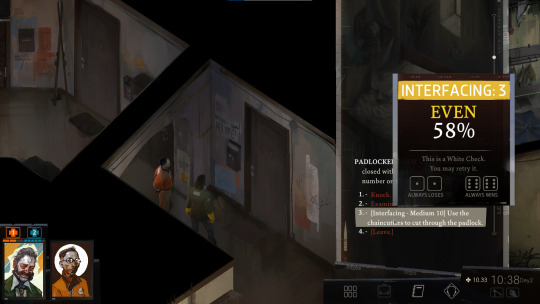
3. [Interfacing - Medium 10] Use the chaincutters to cut through the padlock.
May as well keep breaking into apartments. One of these has to belong to the smoker. (Also, I'm pretty sure this is the only way to get access to this one.)
INTERFACING [Medium: Failure] - What are you doing? You're trying to cut the body of the lock with the chaincutters and it's really not working.

KIM KITSURAGI - "I believe it's the *shackle* you mean to cut, detective." The lieutenant points to the corroded loop with a gloved finger.
-1 Morale
EMPATHY [Medium: Success] - He's just trying to help, don't take it... bad. Relax.
"Don't you think that's what I'm *trying* to do?"
"These chaincutters are broken, Kim."
KIM KITSURAGI - "Perhaps you should give it another go?"

+1 Kim pointed out the shackle.

INTERFACING [Medium: Success] - The shackle snaps like a twig and the lock falls to the floor with a little thud. It should be possible to enter now...
KIM KITSURAGI - "After you, detective."
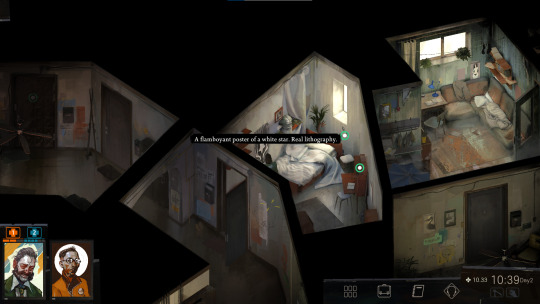
A flamboyant poster of a white star. Real lithography.
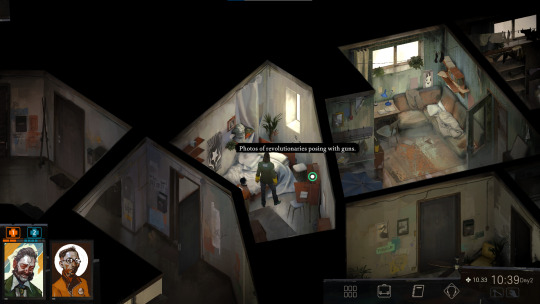
Photos of revolutionaries posing with guns.
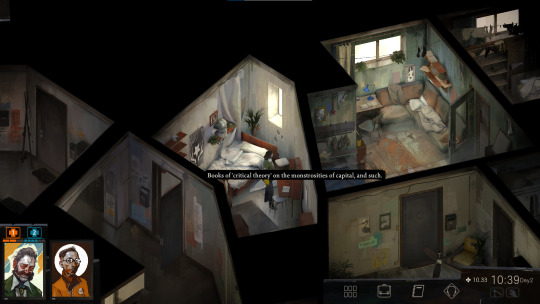
Books of 'critical theory' on the monstrosities of capital, and such.
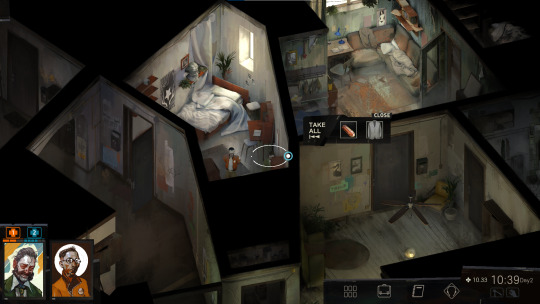
Revolutionaries *love* to pose with their guns.
In the chest is a jacket and a single bullet.
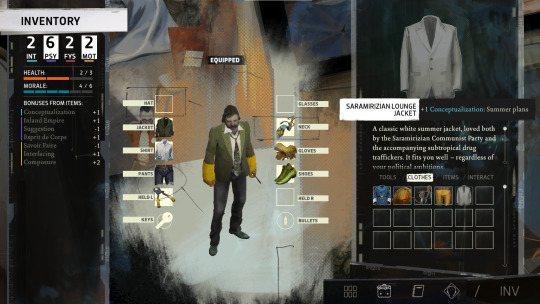
SAZAMIRIZIAN LOUNGE JACKET
+1 Conceptualization: Summer plans
A classic white summer jacket, loved both by the Sazamirizian Commission Party and the accompanying subtropical drug traffickers. it fits you well -- regardless of your political ambitions.
This'll look great with our black jeans. Also, it gives us a useful stat bonus.
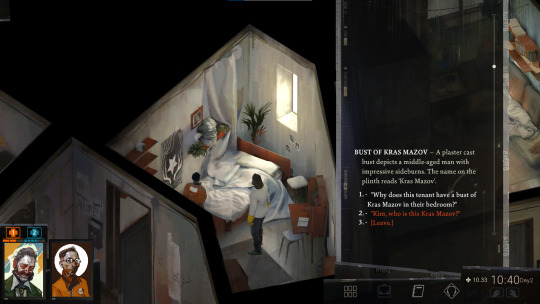
BUST OF KRAZ MAZOV - A plaster cast bust depicts a middle-aged man with impressive sideburns. The name on the plinth reads 'Kras Mazov'.
"Why does this tenant have a bust of Kraz Mazov in their bedroom?"
"Kim, who is this Kraz Mazov?"
KIM KITSURAGI - "The white star... the photos on the wall... I think we have broken into the apartment of a young communard." He looks around, before mumbling to himself: "How fitting."
+5 XP
2. "Kim, who is this Kras Mazov?"
KIM KITSURAGI - "He's known as the father of scientific communism, also known as Mazovianism. His theories about economic history greatly influenced -- some would even say *sparked* -- the Antecentennial Revolution."
2. "Father Mazov, the hero of the working class!" (Salute the statue.)
KIM KITSURAGI - "Whoever lives here definitely shares your enthusiasm." He leans closer to inspect the photos of revolutionaries on the wall.
"There aren't many communists around -- not after the Revolution. Some youths still keep the ideology going, it seems."
3. [Leave.]
Nothing else here.
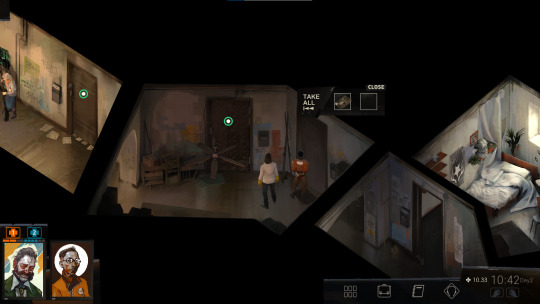
There's a postcard in this box.

POSTCARD "BOOGIE STREET '46"
This crumpled up postcard depicts an open air market in Boogie Street -- 5 years ago. A vendor smiles as dead roosters line his stalls -- hung by their feet from canopy. Red blood flows onto the muddy street, blurry shadows of people pass.
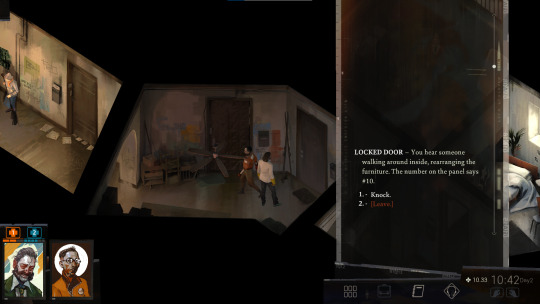
LOCKED DOOR - You hear someone walking around inside, rearranging the furniture. The number on the panel says #10.
Knock.
[Leave.]
LOCKED DOOR - The walking stops abruptly, but no one comes to the door.
INLAND EMPIRE [Medium: Success] - You can feel tension on the other side.
Knock again.
LOCKED DOOR - This time the steps come closer. "Who is this?" demands a female voice, wary and tense.
"This is the police. Open up."
LOCKED DOOR - "Do I *have to* open the door?" You hear the clacking of heels again, as the other side walks right up to the door. Her tone is now getting a defensive edge...
"Do you have a warrant? I'm not obligated to open the door if you don't have a warrant."
KIM KITSURAGI - "Let's go," the lieutenant says, "we don't have a reason to get inside that apartment."
2. [Leave.]

The door #9 is locked.
There's also 0.25 real in a box here.
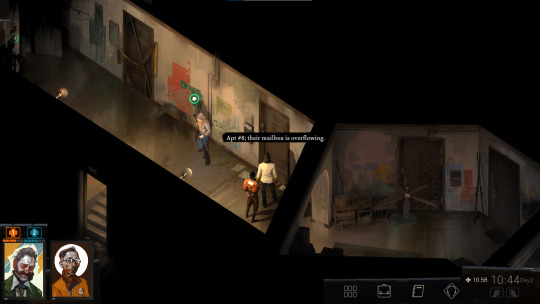
Apt #8, their mailbox is overflowing.

The graffito says: "A firing squad for the rich."

A note reads "Foreclosed by Martinaise Realty Associates."

CLEANING LADY - "Give me a moment." An elderly woman is leaning on her broom, her knuckles white as bone. She seems to be having difficulty breathing.
"The cold never does any good for my bronchitis..." She sneezes into a dirty handkerchief.
"Are you alright? Should I call a doctor?"
"This won't take long, I only have a few questions."
Let's do it later... [Leave.]
CLEANING LADY - "I'm fine, fine, don't you worry about me!" She starts coughing, red spots appearing on her cheeks.
EMPATHY [Medium: Success] - You're still worried. It's very worrying.
CLEANING LADY - "Now, what do you want from me, policeman?"
"Who are you?"
"I am looking for Martin Martinaise."
"I have a few questions about those apartments..."
"Thanks, I'm off." [Leave.]
CLEANING LADY - "I'm no one, just an old woman who cleans these hallways."
"Do you live here?"
CLEANING LADY - "If you can call it living..." She spits on the floor, before wiping it off with a broom. "I have a little room upstairs, right next to the coal room."
"It's barely bigger than a closet, but I don't complain, no…" She juts out her chin, eyes shining. "I have my bed and my aching bones to keep me company and that's all I need from this world."
2. "I am looking for Martin Martinaise."
CLEANING LADY - "Oh, you'll find plenty of Martins here, don't you worry!" She smiles a gap toothed smile when she hears you mention the name.
"What do you mean? I wasn't joking."
"No, you don't understand. I'm looking for a real person named Martin Martinaise. He told me he's Martin Martinaise."
CLEANING LADY - "Pea-brain, someone played a trick on you. Martin Martinaise is a name for *anyone* from Martinaise. Like Jim Jamrock or Raoul Revachol."
+5 XP
RHETORIC [Medium: Failure] - Oops... you really didn't get the joke there.
KIM KITSURAGI - "I thought it was obvious..." He stops before he offends you. "Anyway, officer. We *don't* have the witness' name."
2. "How about a young male in his mid-twenties, dark hair, skinny build? A smoker on the balcony. Know where he lives?"
CLEANING LADY - "Yes-yes. I know who you mean. The scrawny boy who's always smoking like the devil, right?" She looks at the other end of the hallway.
"What's he in trouble for?"
12 notes
·
View notes
Text
Article from The Conversation on our Chicano Park research.
Urban wellbeing is increasingly tied to what urban planners term “green” and “blue” spaces: the parks and waterfronts that our towns and cities may include. Residents are also encouraged to leave the city altogether, to seek out the healthy calm of forest bathing, fell running or cold water swimming.
The potential of play within the urban environment, however, is often overlooked.
Skateboarders have long been invested in what I call “grey” space: the overlooked corners, edges and surfaces of the built environment. Skateboard magazines and videos routinely explore the social and architectural histories of sets of stairs and stone benches.
These spots, largely invisible to the general public, are richly symbolic. In seeing them as ramps and launchpads, skaters transform unremarkable bits of the city into ritual places of magic and wonder.
Recent research conducted with my colleague, Andrea Buchetti, shows that skateparks are sites of unstructured play and community, as well as remembrance and ritual. Otherwise banal and polluted locations are afforded layers of meaning and depth.
Skatepark memorialisation
The Chicano Park skatepark in San Diego is nestled below the imposing, blocky concrete columns of the on-ramps for the city’s Coronado bridge.
Built in 2015, the skatepark features four vibrant murals (by artists including Ricardo Islas) that draw on both the indigenous heritage of this ancient northern Mexican region and skateboard iconography. In memory of lost friends, local skateboarders build shrines at the foot of the paintings using broken skateboards, rocks, cacti and cut flowers.
The five-lane highway bridge above it stands 61 metres tall, allowing safe passage for ships bound to the nearby naval base. Completed in 1969, it links downtown San Diego with the smaller city of Coronado across San Diego Bay.
The space beneath the bridge has long been contested. When built, its route divided a longstanding Mexican American neighbourhood, Barrio Logan, that had already been disrupted by the construction of the Interstate 5 in 1963. Over 5,000 homes and businesses were destroyed in the process.
The state had promised the community a park by way of compensation. But on April 22 1970, Mario Solis, a local student, noticed bulldozers where the park should be, and found out the city was, in fact, constructing a highway patrol base there.
At Solis’s urging, more than 250 residents gathered with shovels and pickaxes to reclaim the land. They planted cacti and trees to create a communal park. After three months of protest, the city conceded to work with the community, and Chicano Park was officially established.
Local artist Salvador Torres was one of the people who lost their homes. In 1973, he galvanised the community into painting murals on the imposing chunks of concrete built in their stead. It was a form of creative resistance. The motifs referenced the cultural heritage of this ancient northern Mexican region, from Aztec symbolism to indigenous plants and beasts, and also Mexico’s colonial experience and revolutionary struggles.
The park is now a protected historic space and landmark. People gather there for annual celebrations on April 22.
Skateboarding as culture and community
Research has long shown the connection between sport and religion. Fans make pilgrimages to stadiums and worship athletes like gods.
Just as a football fan might worship at Wembley stadium in London, a specific neighbourhood curb might hold great significance because of a connection to a famous skater or a historic event. I have shown how skateboarding functions as a lifestyle religion. In the way they observe, perform and organise their communal activity, skateboarders derive spiritual expression and identity from both the physical act of skateboarding and the places in which it is conducted.
Some skateparks have dedicated plaques and permanent memorials designed into skateable features. When legendary San Francisco skateboarder and chief-editor of Thrasher magazine, Jake Phelps, died in 2019, a sculptor in Los Angeles made a concrete tombstone feature to install in the Lower Bob’s DIY skatepark in Oakland. He mixed some used dental floss Phelps had left behind into the concrete. “We don’t got his cremated body,” the artist told Thrasher, “but we got pretty much all the DNA we’re gonna need.”
London’s Skateboard Graveyard on one of the supports of Hungerford Bridge, on the South Bank, is another salient example. For years now, old boards have been thrown down from the Golden Jubilee footbridge in memory of Timothy Baxter, one of two skaters who were attacked and thrown into the river Thames in 1999.
Baxter died as a result and the juvenile attackers were convicted of manslaughter. Many of the skateboarders who take part in the ritual might not know that this is how it began, yet they persist in offering their broken boards to the site.
RIP epitaphs
In 2023, the skatepark in Sacramento’s Regency Park was renamed in honour of Tyre Nichols, a skateboarder who was beaten to death by police officers in Memphis, Tennessee.
Australian graphic design expert Dan Johnston has identified RIP epitaphs as one of the most common types of skateboarding-related graffiti. He cites messages he has noted on the steel ramps and concrete bumps of skater desinations in Singapore, Paris and south Australia – RIPs and Miss Us scrawled in white correction fluid, marker pen or spray paint.
Despite skateboarding’s recent ascent to Olympic status, for many skateboarders it is more a culture – or even a cult – than a sport. It brings diverse people together for unsanctioned play, recasting obstacles – an impassable buckled road in Wiltshire, say – as toys and tools.
In their provocative curves and surfaces, skateparks embody this creativity. They mimic the city beyond, showing how the built environment cannot just be conceived of as a framework for economic activity. Grey space – and grey times – can be transformed if communities, and the DIY cultures they give birth to, are allowed to flourish in the city.
2 notes
·
View notes
Text
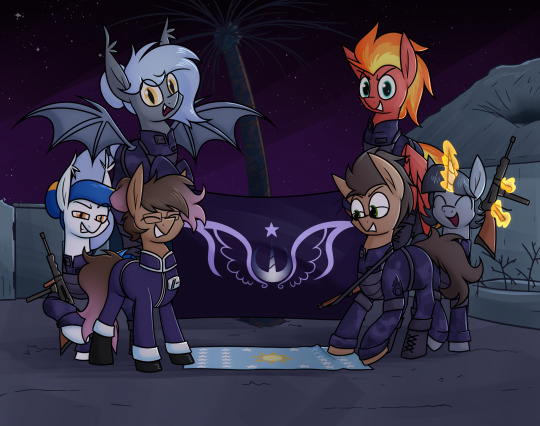
Marfilita reclaimed! The Empire takes yet another step to restoring justice, order, and progress to the island of Puerto Caballo! A great victory has been achieved!
As the might of the Lunar Empire grew and as more of its enemies were crushed beneath its hooves, the Equestrian Provisional Government in Puerto Caballo remained a thorn in its side.
It was bad enough for the Empire that Puerto Caballo was protected by the fleet of the Kingdom of Aquileia, it was even worse when Aquileian and Arisian forces were providing training and supplies to the Puerto Caballans, and made downright humiliating as Arisian intelligence were transporting Puerto Caballan operatives around the world to strike at Lunar power wherever it sought to impose itself.
Yet this would not last. Quietly, the Lunar Empire had a sophisticated plan of its own to reclaim the islands. Through extensive reconnaissance and planning, an invasion force capable of seizing the islands within months was constructed and put into place. The threat of Aquileian intervention was thwarted as the Empire supported the growing revolutionary republican movement in Aquileia itself by providing funds and intelligence to its organisers and giving them shelter in New Mareland. This culminated in the 2 January overthrow of the Kingdom of Aquileia in a coup/uprising by the local republicans, and a new democratic pro-Lunar government was established. At last, the way was clear.
Operation Hurricane was launched on 11 January, the initial landings involving 120,000 soldiers and the overall operation involving nearly 400,000 troops with support from dozens of ships, thousands of aircraft and tanks, and the Empire's most elite combat mages. The defenders, even with all their weapons and training, didn't stand a chance. Just three nights into the invasion, the symbolic village of Marfiltia was taken by Lunar marines. To celebrate their victory, several of the marines involved in the attack had a picture taken of them posing with the Imperial flag over a Loyalist flag, mimicking a famous piece of Loyalist iconography (seen here).
Victory was declared on 26 March with the total collapse of the EPG. Thousands of Loyalists were killed, many more were captured, and those who avoided capture had been scattered to the wind. Or so the Empire thought.
Even though the EPG itself has fallen, resistance remained strong. Deep in the jungles and high in the mountains, a guerrilla insurgency raged on in defiance of the Lunar occupiers. The question was then a matter of who would break first, the vengeful Empire with all its terrifying might or the tenacious rebels with nothing to lose but each other?
https://derpibooru.org/images/3136802
7 notes
·
View notes